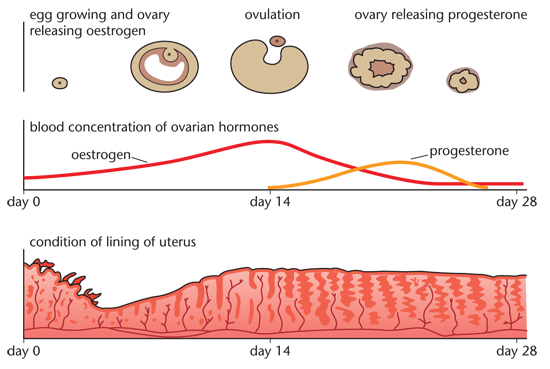- During puberty reproductive hormones cause secondary sex characteristics to develop.
- Oestrogen is the main female reproductive hormone produced in the ovary. At puberty eggs begin to mature and one is released approximately every 28 days. This is called ovulation.
- Testosterone is the main male reproductive hormone produced by the testes and it stimulates sperm production.
- Several hormones are involved in the menstrual cycle of a woman.
- The menstrual cycle is a cycle of physiological changes that take place in women only a monthly basis. It is more commonly known as a period.
Key Stages
- High levels of FSH will stimulate the egg to be ripe in the ovaries
- Oestrogen then stimulates the womb lining to build up so that the woman can be prepared if an embryo does grow inside of her.
- At around day 14, LH stimulates the release of the egg.
- Progesterone would maintain the uterus lining.
- Low levels of oestrogen and progesterone will cause the uterus lining to break down.
- As a result, blood and tissue will be loss – this is called menstruation.
Hormone Interaction
The hormones interact during the menstrual cycle in order for the cycle to take place.
- High levels of FSH stimulates the ovaries to produce oestrogen.
- When oestrogen is produced, it stops FSH production.
- This then causes LH to be produced – and this leads to ovulation on day 14.
- Meanwhile, progesterone levels will increase as it is created by the follicle.
- After day 14, progesterone continues to be released as it stops the lining from breaking down, as well as prevent another egg from being released.
- If a woman is not pregnant, the egg will degenerate with the lining of the womb. Progesterone levels will then drop and menstruation occurs.
